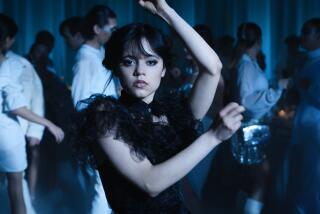From the Disney vault
- Share via
To celebrate Walt Disney’s 100th birthday last December, Walt Disney Home Entertainment released four two-disc DVD sets called “Walt Disney Treasures.” The discs featured episodes from Disney’s two prime-time TV series, Technicolor Mickey Mouse cartoons from the 1930s, Silly Symphonies animated shorts from that decade and all five episodes of the ‘50s miniseries “Davy Crockett.”
The sets were gold to Disney buffs and baby boomers, and sold like hot cakes. In fact, they sold out. “They have done outstanding,” says Robert Chapek, president of Buena Vista Home Entertainment. “We originally thought it would appeal to fans and collectors, but it also hit the mass market with families and adults 30-plus appreciating them as pure entertainment.”
For the record:
12:00 a.m. Dec. 6, 2002 For The Record
Los Angeles Times Friday December 06, 2002 Home Edition Main News Part A Page 2 National Desk 6 inches; 248 words Type of Material: Correction
Disney DVDs -- A headline in Tuesday’s Calendar accompanying a story about vintage Disney material on DVD incorrectly stated there were four such sets released this week. There are three new sets.
For The Record
Los Angeles Times Wednesday December 11, 2002 Home Edition Main News Part A Page 2 ..CF: Y 19 inches; 691 words Type of Material: Correction
Mickey Mouse -- A Dec. 3 Calendar article about three new DVDs from Walt Disney Home Entertainment mistakenly said that the “Mickey Mouse in Black and White” disc features all of the character’s early black-and-white cartoons. It doesn’t.
The success of the first edition of “Treasures” has spawned a follow-up package of sets, released under the expanded title of “Walt Disney Treasures: Wave 2” ($33 each) and arriving in stores today. “Mickey Mouse in Black and White” includes all of Mickey’s early black-and-white cartoons; “The Complete Goofy” showcases all of the beloved goofball’s cartoons; and “Behind the Scenes at the Walt Disney Studios” features many of Disney’s early shorts about his studio and episodes from his ‘50s TV series revolving around animation.
All discs are introduced by film historian Leonard Maltin, author of the book “The Disney Films,” and feature such supplemental material as rare or unseen archival material, story sketch sequences, production art galleries, publicity and memorabilia galleries and interviews.
Maltin actually came up with the idea of “Treasures” a few years back. “I had met with Dick Cook, who is the chairman of the Disney Co.,” Maltin says. “He knows Disney and understands Disney. We had a breakfast meeting and I said you have all of this wonderful material in your vault. Some of it has never been on video and some that has hasn’t been presented in the best way. And now with DVD there are so many opportunities created, things that can be done to showcase this wonderful stuff. And he said, ‘Let’s do it.’ ”
Mickey Mouse made his debut in 1928’s “Steamboat Willie,” the short that also marked the first use of synchronized sound in animation.
These shorts, which end with 1935’s “Mickey’s Service Station,” also marked the big-screen debuts of Minnie Mouse, Pluto and Goofy.
“It’s amazing to actually watch the character evolve film by film and year by year,” Maltin says. “In a sense you are watching animation evolve film by film and year by year. When you go back and look at anything written about Walt from that period, he was constantly exhorting his staff -- ‘we have got to do better.’ So it is not accidental that it has a forward thrust.”
In his introductions, Maltin also puts into historical context some politically incorrect scenes -- a few sequences, for example, satirize Al Jolson’s blackface routines -- in the early Mickey Mouse cartoons. Maltin was glad that Disney included those cartoons unedited.
“They understood that it made sense to do it this way, especially in a set that is so clearly aimed at collectors and Disney buffs as well as kids,” Maltin says. “I think this is the right way to do it, not to censor, not to chop, but set it in the proper context and let people judge for themselves.”
“We didn’t want to put them out just naked without some type of explanation,” Chapek notes.
Maltin also explains in the introductions that the characters in the Mickey Mouse cartoons often smoke, drank and even spit tobacco, and that the humor was often crude by today’s standards.
“The people making these were not sophisticated people,” Maltin says. “Walt was not a sophisticated person. I think he became one, but he wasn’t [early in his career] and neither were his colleagues. A lot of them came from simple backgrounds. I call it barnyard humor and that was their stock in trade. Showing someone’s long johns and pantaloons was funny stuff.”
Perhaps the Disney character that went through the greatest change has been Goofy.
“First there was this guy with the hyena laugh, and then they found the endearing qualities in him and made him a lovable hick. In the 1940s, they came up with this wonderfully off-the-wall idea of having him demonstrate sports, and it worked so well. Those are some of my all-time favorite cartoons. And then the final evolution of Goofy is as a suburban dad and father.”
Maltin says that Disney has committed to a “Wave 3.”
More to Read
The biggest entertainment stories
Get our big stories about Hollywood, film, television, music, arts, culture and more right in your inbox as soon as they publish.
You may occasionally receive promotional content from the Los Angeles Times.











